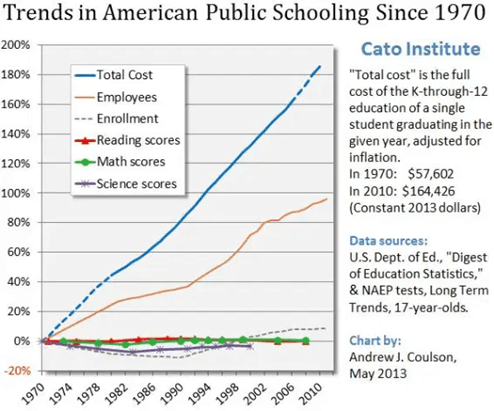Public Education – The Innovation Desert That Leaves a Nation at Risk

A bill to create a school voucher program in Oklahoma failed last month. In a state where school choice polls at 68% favorable, a small school choice bill sponsored by the Senate pro tem and supported by the Governor failed after a divisive debate.
In 2020 I was the Executive Director of an Oklahoma charter school that was authorized by the local public school district. The district retained five percent of our public funding each year as its authorizing fee. When the state passed a law capping charter authorizing fees at three percent of public funding, the district raised our rent in an amount equal to the fee reduction.
These events highlight the critical flaw in the current K-12 education reform movement. Even in a school choice-friendly state like Oklahoma the narrow reforms it champions only occasionally survive the contentious challenge mounted by the traditional system. When reforms do survive, the system easily counteracts them. The special-interest-controlled bureaucratic monopoly that is our public education system is for all intents and purposes, immune to change.
There is however plenty of reasons to call for change in the U.S. compulsory education system. It is expensive, achievement lags internationally, teachers are leaving the profession, and parents feel powerless. It seems to be working for no one. Despite sixty years of disappointing results almost nothing has been done to fix the system. Adults argue and point fingers while kids and society pay the price of inaction.
Making the system’s immunity to change even more frustrating is that education has stagnated while virtually every other field of human endeavor has made progress. We are living longer, living better, and are more prosperous thanks to innovation – new and better ideas displacing old ways of doing things.

America has a culture supported by a system of laws and institutions that respects a person’s right to devise a better way of doing things, take some risk, bring their idea to market, and be rewarded for doing so. The innovator’s version of the American dream.
The enemies of innovation, however, are the hallmarks of our public education system, government bureaucracy, monopoly, and special interests. Government bureaucracies don’t fear failure, they crave resources and therefore serve the source of those resources – higher levels of the bureaucracy. Monopolies do not fear competition, they fear failure and so avoid taking the risks necessary for change. Special interests fear competition and crave influence. They subvert market incentives by amassing disproportionate power.
The contemporary debate on reforming the education system can be summarized as those supporting the traditional system calling for more resources while reformers advocate for various forms of choice. Rigorous analysis of international and domestic spend versus performance data refutes the idea that more spending will improve outcomes. Reformers on the other hand, rarely describe the prerequisite political changes that need to be made to make sustainable reform possible. The solution to the ills of our education system may involve more resources (not for the existing model) and certainly includes greater choice but must be preceded by political reforms that make the system amenable to sustainable innovation.
Specifically, the political processes that control public education must be brought into line with the established norms of our electoral system. School board elections are commonly held at times other than when general elections are held. For example, my home state elects school board members in February. These off-cycle elections have low voter turnout and therefore give disproportionate influence to special interests, more specifically the teachers’ unions. They frequently produce school boards that have different views on education than the community the board represents.
School board elections also commonly omit partisan labels from the ballot. The average voter doesn’t have the time to research the positions of individual school board candidates and so, even in on-cycle elections will leave that choice blank. Again, giving more influence to special interests. Partisan labels inform voters about likely candidate positions.
Finally, about twenty-five percent of states elect the top educational executive independent of the governor. Running for office in an election forces candidates to curry special interest favor. Being elected independently makes the state head of instruction a natural competitor for the governor and therefore prone to unproductive conflict.
Conclusion
Narrow reforms proposed in a system dominated by a government monopoly controlled by special interests will either not survive the legislative process or be easily counteracted once implemented. Real progress in the U.S. K-12 system will take broad and aggressive reforms which can only be possible after we break the hold innovation’s enemies have on the education system through prerequisite political reforms.
Read the full report here.










